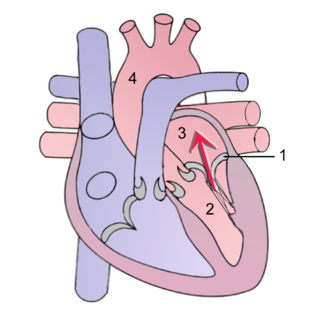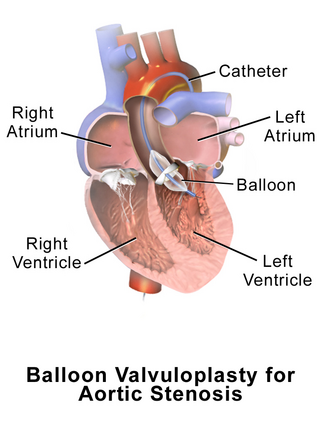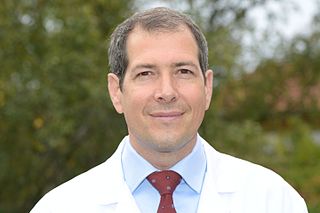
Interventional cardiology is a branch of cardiology that deals specifically with the catheter based treatment of structural heart diseases. Andreas Gruentzig is considered the father of interventional cardiology after the development of angioplasty by interventional radiologist Charles Dotter.

Mitral regurgitation(MR), also known as mitral insufficiency or mitral incompetence, is a form of valvular heart disease in which the mitral valve is insufficient and does not close properly when the heart pumps out blood. It is the abnormal leaking of blood backwards – regurgitation from the left ventricle, through the mitral valve, into the left atrium, when the left ventricle contracts. Mitral regurgitation is the most common form of valvular heart disease.
Aortic valve replacement is a procedure whereby the failing aortic valve of a patient's heart is replaced with an artificial heart valve. The aortic valve may need to be replaced because:

An artificial heart valve is a one-way valve implanted into a person's heart to replace a heart valve that is not functioning properly. Artificial heart valves can be separated into three broad classes: mechanical heart valves, bioprosthetic tissue valves and engineered tissue valves.

Valvular heart disease is any cardiovascular disease process involving one or more of the four valves of the heart. These conditions occur largely as a consequence of aging, but may also be the result of congenital (inborn) abnormalities or specific disease or physiologic processes including rheumatic heart disease and pregnancy.

Aortic valvuloplasty, also known as balloon aortic valvuloplasty (BAV), is a procedure used to improve blood flow through the aortic valve in conditions that cause aortic stenosis, or narrowing of the aortic valve. It can be performed in various patient populations including fetuses, newborns, children, adults, and pregnant women. The procedure involves using a balloon catheter to dilate the narrowed aortic valve by inflating the balloon.

Valve replacement surgery is the replacement of one or more of the heart valves with either an artificial heart valve or a bioprosthesis. It is an alternative to valve repair.

Transcatheter aortic valve replacement (TAVR) is the replacement of the aortic valve of the heart through the blood vessels. The replacement valve is delivered via one of several access methods: transfemoral, transapical, subclavian, direct aortic, and transcaval, among others.
Mitral valve replacement is a procedure whereby the diseased mitral valve of a patient's heart is replaced by either a mechanical or tissue (bioprosthetic) valve.

Lutembacher's syndrome is a very rare form of congenital heart disease that affects one of the chambers of the heart as well as a valve. It is commonly known as both congenital atrial septal defect (ASD) and acquired mitral stenosis (MS). Congenital atrial septal defect refers to a hole being in the septum or wall that separates the two atria; this condition is usually seen in fetuses and infants. Mitral stenosis refers to mitral valve leaflets sticking to each other making the opening for blood to pass from the atrium to the ventricles very small. With the valve being so small, blood has difficulty passing from the left atrium into the left ventricle. Septal defects that may occur with Lutembacher's syndrome include: Ostium primum atrial septal defect or ostium secundum which is more prevalent.
David H. Adams is an American cardiac surgeon and the Marie-Josée and Henry R. Kravis Professor and Chairman of the Department of Cardiothoracic Surgery, Icahn School of Medicine at Mount Sinai Hospital in New York City. Dr. Adams is a recognized leader in the field of heart valve surgery and mitral valve reconstruction. As director of Mount Sinai Mitral Valve Repair Center, he has set national benchmarks with >99% degenerative mitral valve repair rates, while running one of the largest valve repair programs in the United States. Dr. Adams is the co-inventor of 2 mitral valve annuloplasty repair rings – the Carpentier-McCarthy-Adams IMR ETlogix Ring and the Carpentier-Edwards Physio II Annuloplasty Ring, and is a senior consultant with royalty agreements with Edwards Lifesciences. He is also the inventor of the Tri-Ad Adams Tricuspid Annuloplasty ring with a royalty agreement with Medtronic. He is a co-author with Professor Alain Carpentier of the benchmark textbook in mitral valve surgery Carpentier's Reconstructive Valve Surgery. He is also the National Co-Principal Investigator of the FDA pivotal trial of the Medtronic-CoreValve transcatheter aortic valve replacement device.
The pericardial heart valve was invented by Marian Ionescu, a British surgeon working at the General Infirmary in Leeds, England. He created this artificial bioprosthetic heart valve as a three-cusp structure made of chemically treated bovine pericardium attached to a Dacron cloth-covered titanium frame.
A valvulotomy, valvotomy, valvuloplasty, or valvoplasty is a procedure used in heart valve surgery that consists of making one or more incisions at the edges of the commissure formed between the two, or three tricuspid valve leaflets. This relieves the constriction of valvular stenosis.

A hybrid cardiac surgical procedure in a narrow sense is defined as a procedure that combines a conventional, more invasive surgical part with an interventional part, using some sort of catheter-based procedure guided by fluoroscopy imaging in a hybrid operating room (OR) without interruption. The hybrid technique has a reduced risk of surgical complications and has shown decreased recovery time. It can be used to treat numerous heart diseases and conditions and with the increasing complexity of each case, the hybrid surgical technique is becoming more common.
Gilles Dreyfus is a French cardiac surgeon.

MitraClip is a medical device used to treat mitral valve regurgitation for individuals who should not have open-heart surgery. It is implanted via a tri-axial transcatheter technique and involves suturing together the anterior and posterior mitral valve leaflets.
Alain Cribier, FACC, FESC is a French interventional cardiologist, who is a Professor of Medicine and Director of Cardiology at the University of Rouen's Charles Nicolle Hospital. Alain Cribier is best known for performing the world's first transcatheter aortic valve implantation in 2002, the first mitral commissurotomy in 1995 and the first balloon aortic valvuloplasty in 1986.

Christoph Huber MD, FMH, FECTS is a Swiss cardiac surgeon who is a professor and the head of the Division of Cardiac and Vascular Surgery at the University Hospital Geneva, Switzerland.
Percutaneous pulmonary valve implantation (PPVI), also known as transcatheter pulmonary valve replacement (TPVR), is the replacement of the pulmonary valve via catheterization through a vein. It is a significantly less invasive procedure in comparison to open heart surgery and is commonly used to treat conditions such as pulmonary atresia.
Joseph E. Bavaria, M.D., FACS, FRCS (Edin) ad hom, is an American cardiothoracic surgeon a professor of surgery at the University of Pennsylvania and Director of its Thoracic Aortic Surgery Program. Bavaria is known as a leading figure in clinical trials for catheter-based aortic valve replacement (TAVR), thoracic aortic surgery, and aortic endograft procedures (TEVAR). He wrote more than 600 research papers and founded the Penn Aortic Center. Bavaria served as the 52nd president of the Society of Thoracic Surgeons (STS) from 2016 to 2017, the 3rd President of the Thoracic Surgery Foundation (TSF) (2019-2022), the Chairman of The Society of Thoracic Surgeons/ACC TVT Registry Steering Committee (2017-2020) and an International Councilor of the European Association for Cardio-Thoracic Surgery (EACTS) (2021-2024) Bavaria has performed more than 9,000 surgeries throughout his career as of 2019.











